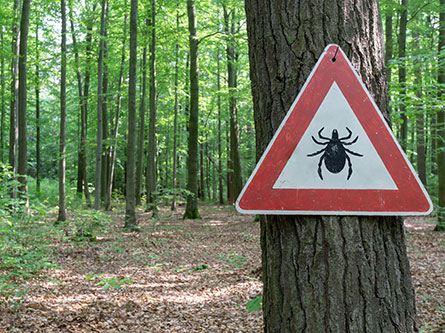Warmer weather means more people are outside hiking, camping and exploring the great outdoors. However, that can lead to an increased risk of ticks which carry Lyme disease.
Our experts share information on ticks, Lyme disease and ways to keep yourself and your family safe.
What is Lyme disease?
Lyme disease is an illness caused by bacteria. Humans get this disease through tick bites.
Ticks that can carry these bacteria, called Borrelia, live in most of the U.S., as well as Europe and some parts of Canada.
According to the Centers for Disease Control and Prevention (CDC), a recent estimate based on insurance records indicates about 476,000 Americans are diagnosed with and treated for Lyme disease each year.
What are the symptoms of Lyme disease?
Lyme disease symptoms tend to show up in stages. Some people may not experience the typical early stage of Lyme disease.
A rash can be common in the beginning of Lyme disease but doesn't always happen. Other early symptoms include fever, headache, fatigue, joint stiffness and swollen lymph nodes.
In the next stage of Lyme disease, symptoms can show up 3 to 10 weeks after a tick bite. This is when symptoms get more serious and widespread. These symptoms may include:
- Severe headaches and neck stiffness
- Rashes on other areas of the body
- Loss of muscle tone in the face or droop on one or both sides (facial palsy)
- Severe joint pain and swelling, especially in the knees and other large joints
- Irregular heartbeat (Lyme carditis)
- Dizziness
- Shooting pain, numbness, or tingling in the hands and feet
If you have concerns about any of these Lyme disease symptoms, it's important to talk to your doctor as soon as you can. Early diagnosis and treatment can help improve your outcome.
Learn more about Lyme disease symptoms from the CDC
How can you recognize Lyme disease? What are the early symptoms?
Early signs of Lyme disease that tend to show up 3 to 30 days after a tick bite include the following:
- Fever
- Chills
- Headache
- Extreme tiredness
- Muscle and joint aches
- Swollen lymph nodes when there is no rash
Another early symptom of Lyme disease is called erythema migrans (EM) rash. About 70-80% of people infected with Lyme disease will get this rash. It shows up typically about 7 days after a tick bite but can appear between 3 and 30 days after. It expands gradually over several days and can grow to about 12 inches or more.
EM rash may appear anywhere on the body. It can feel warm to the touch, but it's rarely itchy or painful.
What are the treatments for Lyme disease?
For tickborne diseases, such as Lyme disease, treatment is based on symptoms, history of exposure to ticks, and in some cases, blood test results. It's important to get treatment for Lyme disease as early as possible.
Most diseases that come from a tick, including Lyme disease, can be treated with a short course of antibiotics.
Learn more about Lyme disease treatment
What should you do if you find a tick attached to you?
If you find a tick on yourself or on a person you're with, here’s what you should do:
- Use fine-tipped tweezers to grasp the tick as close to the skin as you can. Pull upward with steady, even pressure. Don't twist or jerk the tick.
- After removing the tick, clean the bite area and your hands with rubbing alcohol or soap and water. Never smash a tick with your fingers.
- Dispose of the tick by flushing it down the toilet. If you would like to bring the tick to your health care provider for identification, place the tick in a zippered plastic bag or sealed container with a moist cotton ball or paper towel.
- Talk to your health care provider if you experience any of the symptoms of Lyme disease.
What are some tips to prevent tick bites?
If you are planning an outdoor activity, especially those in a heavily wooded area, follow these precautions to protect yourself from tick bites.
- Wear long-sleeved, light-colored clothing, with tightly woven fabric. This gives ticks less area to target and allows you to see ticks on your clothing. Tuck your pants into your socks, shoes, or boots so that ticks cannot easily get under your pant legs.
- Use insect repellent that is registered with the Environmental Protection Agency (EPA) and contains products like DEET, picaridin, and oil of lemon eucalyptus (OLE). You can also treat clothing, boots, and other gear with products containing 0.5% permethrin. Permethrin remains protective through several washings.
- Check for ticks after you've been outside. Ticks can ride into your home on clothing and pets, then attach to a person later. Make sure you carefully examine pets, coats, and daypacks once you're done being outdoors.
- Check your dogs and other pets for ticks, too. Run your fingers through your pet's fur with a little bit of pressure to feel for any bumps. It’s also important to look for ticks around the ears, toes, tail, eyes, groin and under the collar. Discuss using tick prevention products for your pets with your veterinarian.
- Shower within two hours of coming indoors. This has been shown to reduce your risk of getting Lyme disease and may be effective in reducing the risk of other tickborne diseases. Showering may help wash off unattached ticks. It's also a good time to do a tick check on yourself.
Read more from UC Davis Health: What you can do to reduce your chances of getting a tick bite




